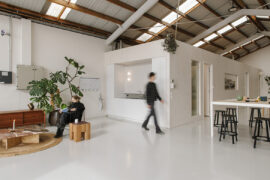Hayball has partnered with the Australian Social Value Bank (ASVB) to launch a ground-breaking initiative on measuring the social value of architecture. We spoke with architect Eilish Barry about the concept and its ramifications.

October 10th, 2023
We recently reported on the ambitious – dare we say, audacious – approach set out by Hayball with regard to the social impacts of architecture and design. Partnering with the ASVB, Hayball is seeking to set a new standard in terms of being able to measure and quantify the social value of design in Australia.
Calling it a new standard might not be inaccurate, but it scarcely captures the scope of the proposition. It’s really an invite, or a provocation, towards a different way of thinking about and executing architectural projects. As a practice that seeks to put questions of community and social value at the core of each project, Hayball sees it as a way to enshrine these concerns into every part of the built environment – a way of turning the abstract concept of social value into something concrete and meaningful.
Eilish Barry, a UK-trained architect now based in Sydney with Hayball, has led the research components of the new approach. As she puts it, however, it’s perhaps not a new approach at all. Rather, it’s a way of taking what Hayball is already doing, giving it a name and making it count.

“When I joined and took on this piece of research, I saw that Hayball was creating communities and this huge social impact but just didn’t really have a way of tracking and measuring it,” explains Barry. Having moved to Sydney from the UK, she notes how legislation there has already shifted the industry into this space – since 2012, she explains, any project bids over £30,000 have to report on the social and environmental value added.
“We wanted to find a way to measure our impact on the users of our buildings, as well as tie into the broader industry and government framework,” Barry adds. “I carried out a piece of research that looks at explaining what social value is, how it impacts us as architects and proposes a method to the industry on how to measure it.”
There are, however, some serious questions and concerns thrown up by this approach. How can something like social value be measured and even monetised? Surely there are dangers involved in trying to quantify things, such as wellbeing or user responses to the built environment, that are essentially qualitative? In a well-meaning attempt to turn ideals into concrete outcomes, could the architect unwittingly end up simply speaking the language (and being at the service) of the developer?
The answer, according to Barry, is to make sure the approach is holistic. Yes, putting a dollar value on things is part of it – the ASVB, for instance, has calculated that CRT+YRD creates $517,023 of social value in the first year, or $2.24m over the next five years – but it’s not the whole story.
Related: Nightingale and the question of density

“There are mixed reactions globally to quantifying social value, and it’s an ongoing debate,” says Barry. “The reason we wanted to test it in this research project is that it’s never been done before – it’s a first for architecture in Australia.
“Social value has been measured in non-for-profit and other sectors for a long time already, but it absolutely requires a holistic view – you need quantitative data, but also the qualitative aspects. You need the whys, the quotes and the reasons given by the users themselves. The monetary value has its place but is never presented alone – it should always be together with these, not one or the other.”
Seeking to monetise and quantify is not what makes this approach novel, then. It’s doing it alongside and as part of a wider, multifaceted and nuanced model that includes elements such as questionnaires. “Turning non-market goods such as wellbeing into valuation and something measurable is not a new concept, but I think the danger only comes when people don’t understand it. If we don’t monetise, these kinds of wellbeing decisions often get left out of the equation.”

So, how does it actually work? Hayball’s methodology starts with an overarching social value framework with 15 social outcomes grouped under three pillars. “Ideally, we get the whole project team to agree which outcomes we want to create on the basis of local needs through speaking to the community and the client. Then you’d agree on the design features that will help achieve those outcomes,” explains Barry.
Hayball points to Nightingale Village, for which it was executive architect working in collaboration with Architecture architecture, Austin Maynard Architects, Breathe, Clare Cousins Architects and Kennedy Nolan, as a prime example of threading social value into a project. The initiative has used CRT+YRD, part of the wider Nightingale project, as a test case for the new research framework.
An emphasis on social connection at CRT+YRD can be seen in built form through the widening of circulation spaces as places for people to meet each other. Again, this concept as a design truism is nothing new, but threading it into a wider framework that can quantify, and therefore possibly hold other parties to account in the process, is a potential game-changer.

Barry adds another example in relation to a current project: “We know that providing more green space is good for social cohesion, wellbeing and the environment. If you look at without a dollar figure, it doesn’t make as much financial sense – but seeing the dollar value of not doing it helps to join a conversation from which architecture is often pushed aside.”
Amidst these important ideas, Hayball is calling for more people and practices across the industry to support the initiative by engaging in the robust process of testing and finding the best ways of combining quantitative with qualitative data. It’s a way, notes Barry, of starting a conversation and it’s an invite for the whole industry – including larger bodies such as the AIA – to join the debate.
The report also arrives alongside a wider milestone for Hayball: “We’ve framed the 40th anniversary in terms of social value because I think we’ve always cared about this, but without calling it by its name,” says Barry. “Measuring social value is a really beautiful opportunity for us to formalise what we’re already doing into a single framework and then share it with the rest of the industry.”
Hayball
hayball.com.au
ASVB
asvb.com.au
Photography
Tom Ross (Nightingale Village)
We think you might also be interested to read about Hayball’s work on The Alfred Hospital.
INDESIGN is on instagram
Follow @indesignlive
A searchable and comprehensive guide for specifying leading products and their suppliers
Keep up to date with the latest and greatest from our industry BFF's!
The new range features slabs with warm, earthy palettes that lend a sense of organic luxury to every space.

Architect, designer and craftsman Adam Markowitz bridges the worlds of architecture and fine furniture, blending precision, generosity and advocacy to strengthen Australia’s craft and design community.

With its latest outpost inside Shanghai’s bustling Hongqiao International Airport, HARMAY once again partners with AIM Architecture to reimagine retail through colour, movement and cultural expression.
The internet never sleeps! Here's the stuff you might have missed

Kiri Morgan, Director at Nightworks Studio, talks to us about the New Zealand practice’s very own new production space at Lawson St.

In contemporary interiors, ensuring a sense of comfort and wellbeing means designing and specifying finishes and products that support all the senses.